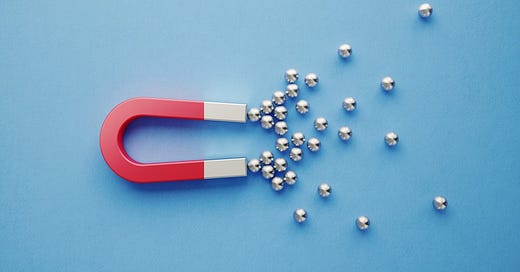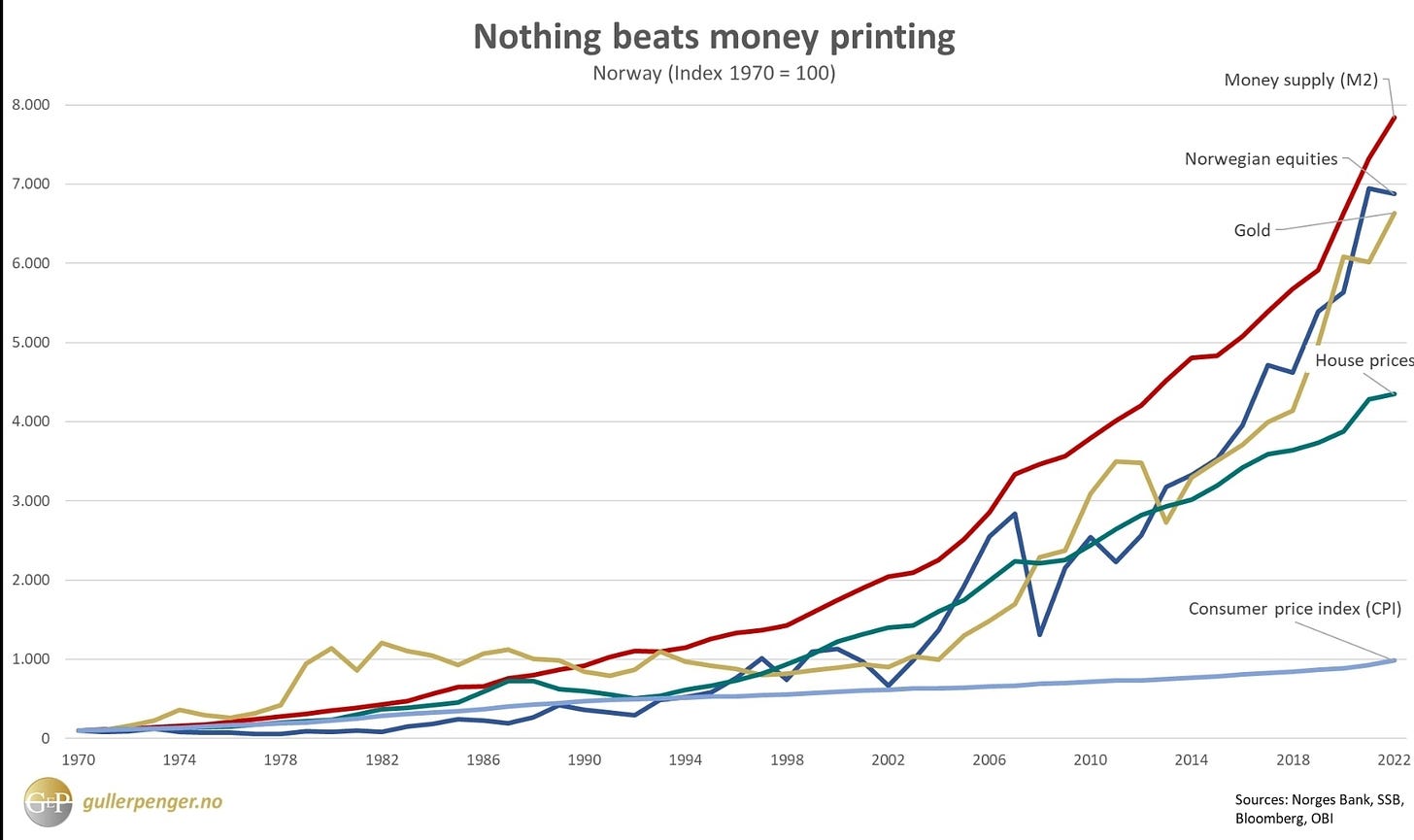Nothing beats money printing
Nothing beats money printing
Few understand what inflation is. This is a shame because inflation is of major importance to everybody.
There are two main reasons why the general population doesn’t understand it. Firstly, instead of having a look at the practicalities of what we call “monetary policy”, people stare blindly at ever increasing prices. And secondly, most of the economists and the representatives of central banks who talk about inflation, are less than transparent. They only add to the confusion.
Therefore, I would like to take the opportunity to shed some light on this important topic. I’ll demonstrate that inflation isn’t complicated at all. In fact, it’s extremely easy to understand what this is all about.
Let’s begin with having a look at what central bank governors have to say about inflation:
Jerome H. Powell, who is the Governor of the Federal Reserve, which is the central bank in the US, used to blame the recent inflation problems in the US on the war in Ukraine. For instance, in the press conference on the 21th September 2022, he said:
“Although gasoline prices have turned down in recent months, they remain well above year-earlier levels, in part reflecting Russia’s war against Ukraine, which has boosted prices for energy and food and has created additional upward pressure on inflation.”
When Reuters’ journalist Howard Schneider at the press conference on the 1st February this year asked Powell why he had “taken out references to the war”, Powell’s response didn’t offer much of a clarification. He instead referred to ongoing price “disinflation” in some sectors, while the inflation still was increasing in other sectors. As we see, Powells focus had shifted towards what we can call “explaining higher prices with higher prices”.
His colleague Christine Lagarde, who is the Governor of the European Central Bank, was a guest at the Irish state broadcaster RTE's "The Late Show" on 28th October last year. In much the same way as Powell, she too blamed Putin's invasion of Ukraine and added that "The inflation has just pretty much come from nowhere".
A third example is the speech presented by Ida Wolden Bache, the Governor of the Norwegian central bank, Norges Bank, on 16 February this year. She also spent lots of time blaming war for inflation. Wolden Bache also claimed that "As mentioned, the main driver of the jump in inflation has been higher prices for energy and imported inputs", which is just another reference to the “high prices cause high prices” theory.
But what exactly is inflation? Where does it come from and what causes it?
The Austrian economist Friedrich Hayek once said that “Inflation is made by the government and its agents, nobody else can do anything about It”. His American colleague Milton Friedman held the same opinion. He stated that "What produces it is too much government spending and too much government creation of money, and nothing else”. You should take note that no economists argue against these to experts in the field of monetary policy, who both became Nobel Laureates.
In today's monetary system, the banks and the central banks are the key “agents” that Hayek referred to. We will get back to that shortly, but first, let’s have a look at what money is, and how it is created:
Roughly 95% of all money is created when banks provide loans to their customers. This type of money is what we call “bank money”. Former deputy Governor of Norges Bank Jon Nicolaisen gave a speech before the Norwegian Academy of Science and Letters on 25 April 2017, where he explained it in a precise manner:
"When you take out a loan from a bank, the bank deposits the loan into your account. The deposit – the money – is created by the bank when the loan is granted. It doesn't pull the money from another person's account or a vault filled with cash. The money the bank lends you, it has created itself – out of nothing."
It almost sounds like a fairy tale, that the bank’s are allowed to create money “out of nothing”. But this is the reality. This is how the modern “printing press” works. You just have to wrap your head around it.
Now, let’s look at how the “government agents” control the money supply:
The banks and the central bank together constitute a cartel mandated by law. This cartel regulates the money supply and the price of money, i.e., the interest rate. It is the central bank, which through its decisions on the so-called "key policy rate", that coordinates how much banks are allowed to lend.
A high key policy rate means that banks loan out less money than when it is low. The central bank also has other tools at its disposal. But it’s the key policy rate that is the most important tool that the central bank uses to control the growth of the money supply.
If we go back to Hayek’s and Friedman's observations, we can more specifically say that over time, the money supply in many of the so-called “Western countries”, such as for instance the US and Norway, increases by an average of 7-8% per year. This means, that the main job of the central banks, practically speaking, is to make sure that the money supply increases by 7-8 % per year.
The expansion of the money supply dilutes the value of all the money which previously circulated in the economy. At a 7 % annual rate, the value of the money is halved after 10 years. Within 16 years, the value will be only one-third, and over the course of 100 years, the value will be reduced by 99.9%.
It’s the increase in the money supply that explains why prices, as measured by the official consumer price indices, have increased 30-fold in the US and 65-fold in Norway since 1914.
The effect is even more pronounced in other economic goods, which the graph below demonstrates:
As we can see, the expansion of the money supply in Norway in the period 1970 to 2022 made prices go up and up and up. But the value of economic goods, whether we talk about values that are expressed by stock indices, gold prices or the average house pri8ces, was unable to increase at the rate of the expansion of the money supply. In short – nothing beats the printing press.
During the COVID-19 pandemic years of 2020-2021, the money supply increased by 40% in the US, and by 25% in Norway. This, which came on top of the money supply growth in previous years, is the reason why prices got out of control.
In the big picture, war and other events are mere "noise". And it’s not the case that "increased prices are caused by increased prices", which is akin to explaining that “the world champion in downhill skiing is the world champion because he is faster than the others”.
The governors will not easily admit that the central banks’ control of the money supply is the cause of inflation. You may ask why they don't want to focus on that. The history's most famous economist, John Maynard Keynes, gave us a clue. In 1919, when he wrote the book "The Economic Consequences of the Peace", he explained the effect of the inflation policy:
"In this way, the state can secretly and unnoticed confiscate the fortunes of its citizens and not one person out of one million will discover the theft."
He showed that money printing gave governments the opportunity to raise large loans. The states could use the loans to gain control of an ever-increasing share of society's resources, without having to increase taxes. When the monetary supply expanded over time, the governments could make downpayments with money that was worth much less compared with the situation when they incurred the debt.
Modern day inflation policy has facilitated a rapid growth of the states. This graph shows the public sectors’ spending as a share of the GDP in the US in the period 1880 to 2011:
It had stayed at around 2 % until 1916, before it grew rapidly to 45 % in 2011. Later, it topped out at 47 % in 2020. The development has been pretty much the same in the rest of the Western countries. For instance, in 2020 it was roughly 66 % in Norway, which was 11 times higher than in 1900.
When we include petroleum revenues, the Norwegian government no longer runs a budget deficit. Nevertheless, the government directly receives a share of the new money immediately after the bank has paid out loans to its customers. The 2.5 % stamp duty is an example of a tax that enables the Norwegian government to get a nice little share of the newly created money.
The debt-based inflation economy also means that others who can take out large loans, especially the biggest corporations, enrich themselves at the expense of everyone else. The newly created money can be compared with a big magnet, as the loans outcompete wealth that is a result of hard work and savings. As a result the system enables the richest of the rich to gobble up all kinds of scarce resources in the real economy, such as workers, real estate and productive capital. Debt beats sweat.
In the US, for example, the one percent richest increased their share of Americans' wealth by one-third during the two years of extreme money printing in 2020-2021. They now control roughly one-third of the Americans’ wealth. The effect was the same in Norway, albeit not as pronounced. The one percent richest Norwegians currently control as much as one-fifth of the Norwegians’ wealth. This is noteworthy because Norway is the country in the world with the least economic inequality. Globally, the "one-percenters" now control half of the world's wealth.
The redistributive effect of the inflation policy is gargantuan. The poor, who see little of the new money, but who still must pay the higher prices for food and shelter, suffers the most, while the middle class is now rapidly being wiped out. Never before in the history of humankind did we see such a big wealth transfer as the one that the expansion of the money supply made possible during the COVID-19 pandemic.
Once you stop staring blindly at the prices, you realize that inflation isn’t at all complicated.
Inflation is a policy. Simple as that.
***
PS: Something beats money printing. I’ll get back to that later.
Rune Østgård is the author of “Fraudcoin: 1000 Years of Inflation as a Policy”.
Follow me on Twitter - @enur72
Go here if you want to know what the readers say about the book.
You can buy the English version of Fraudcoin at Amazon. The Norwegian version is available at Gull er Penger, Ark and Norli.
Contact me at rune@advokatostgard.no if you would like to have a signed copy.






